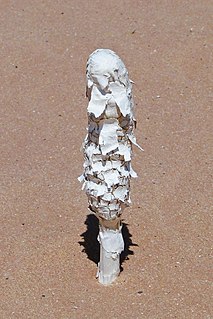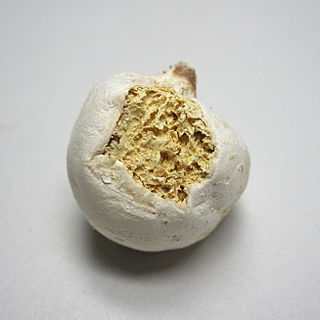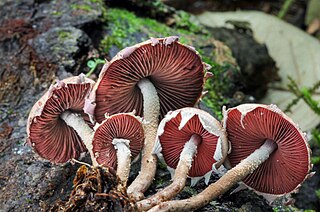
The Agaricaceae are a family of basidiomycete fungi and include the genus Agaricus, as well as basidiomycetes previously classified in the families Tulostomataceae, Lepiotaceae, and Lycoperdaceae.

Coprinus is a small genus of mushroom-forming fungi consisting of Coprinus comatus - the shaggy ink cap (British) or shaggy mane (American) - and several of its close relatives. Until 2001, Coprinus was a large genus consisting of all agaric species in which the lamellae autodigested to release their spores. The black ink-like liquid this creates gave these species their common name "ink cap" (British) or "inky cap" (American).

The Psathyrellaceae are a family of dark-spored agarics that generally have rather soft, fragile fruiting bodies, and are characterized by black, dark brown, rarely reddish, or even pastel-colored spore prints. About 50% of species produce fruiting bodies that dissolve into ink-like ooze when the spores are mature via autodigestion. Prior to phylogenetic research based upon DNA comparisons, most of the species that autodigested were classified as Coprinaceae, which contained all of the inky-cap mushrooms. However, the type species of Coprinus, Coprinus comatus, and a few other species, were found to be more closely related to Agaricaceae. The former genus Coprinus was split between two families, and the name "Coprinaceae" became a synonym of Agaricaceae in its 21st-century phylogenetic redefinition. Note that in the 19th and early 20th centuries the family name Agaricaceae had far broader application, while in the late 20th century it had a narrower application. The family name Psathyrellaceae is based on the former Coprinaceae subfamily name Psathyrelloideae. The type genus Psathyrella consists of species that produce fruiting bodies which do not liquify via autodigestion. Psathyrella remained a polyphyletic genus until it was split into several genera including 3 new ones in 2015. Lacrymaria is another genus that does not autodigest its fruiting bodies. It is characterized by rough basidiospores and lamellar edges that exude beads of clear liquid when in prime condition, hence the Latin reference, lacryma (tears).

Leucocoprinus is a genus of fungi in the family Agaricaceae. Its best-known member is the yellow pot-plant mushroom, found worldwide. The type species is Leucocoprinus cepistipes. The genus has a widespread distribution and contains about 40 species. It includes some highly derived cultivars grown by the Acromyrmex and Atta leaf-cutting ants in an evolved ant–fungus mutualism.

Podaxis is a genus of secotioid fungi in the family Agaricaceae. Species, which have the appearance of a "stalked-puffball", have a worldwide distribution, and tend to be found growing solitary or scattered on sandy soils, especially in arid regions. Although close to 50 species have been described, it has been argued that many of them may represent extremes in the natural range of variations found in Podaxis pistillaris.

Nidularia is a genus of nine species of fungi in the family Agaricaceae. Their fruit bodies resemble tiny egg-filled bird nests. The name comes from the Latin nidus meaning nest. The related genus Mycocalia was segregated from Nidularia in 1961 based on differences in the microscopic structure of the peridium.

Battarrea is a genus of mushroom-producing fungi. The genus used to be classified in the family Tulostomaceae until molecular phylogenetics revealed its affinity to the Agaricaceae. Species of Battarrea have a peridium that rests atop an elongated, hollow stipe with a surface that tends to become torn into fibrous scales. Inside the peridium, the gleba consists of spherical, warted spores, and a capillitium of simple or branched hyphal threads that have spiral or angular thickenings. The genus is named after Italian priest and naturalist Giovanni Antonio Battarra.

Arachnion is a genus of gasteroid fungi in the family Agaricaceae.
Barcheria is a fungal genus in the family Agaricaceae. This is a monotypic genus, containing the single sequestrate species Barcheria willisiana, found in western Australia.
Crucispora is a genus of fungi in the family Agaricaceae. The genus, described by mycologist Egon Horak in 1971, contains two species found in New Zealand and Asia.

Gastropila is a genus of fungi in the family Agaricaceae. The genus, described in 1973, contains four puffball-like species distributed in the Americas.

Holocotylon is a genus of fungi in the family Agaricaceae. It was circumscribed by American mycologist Curtis Gates Lloyd in 1906 with H. brandegeeanum as the type species.

Melanophyllum is a genus of fungi in the family Agaricaceae. The widespread genus contains four species.

Panaeolopsis is a genus of fungi in the family Agaricaceae. The genus has a widespread distribution and contains four species. Panaeolopsis was circumscribed by Rolf Singer in 1969 with P. sanmartiniana as the type species.
Phlebonema is a fungal genus in the family Agaricaceae. It is a monotypic genus, containing the single species Phlebonema chrysotingens, described by Roger Heim in 1929 from Madagascar. According to the Dictionary of the Fungi, the placement of this little-known genus in the Agaricaceae is uncertain.

Ripartitella is a genus of fungi in the family Agaricaceae. The genus was described by Rolf Singer in 1947.

Tulostoma is a genus of fungi in the family Agaricaceae. Species in the genus are commonly known as stalkballs, or stalked puffballs.
Smithiomyces is a genus of fungi in the family Agaricaceae. It was circumscribed by Rolf Singer in 1944. The type species, S. mexicanus, was formerly placed in Amanita, as well as the now obsolete Leucomyces and Venenarius. The genus was named to honor American mycologist Alexander H. Smith. S. dominicanus was described from the Dominican Republic in 2015.

The Capnodiaceae are a family of fungi in the Ascomycota, class Dothideomycetes. Species in the family have a widespread distribution, and are especially prevalent in tropical and subtropical areas, as well as temperate rainforests.















